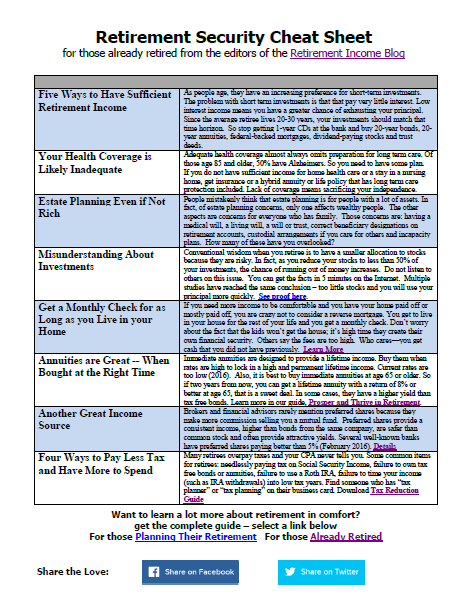Your retirement financial concerns may include income to live on, travel, gifting, and making bequests to heirs and charity. What can you achieve among these? The value of your investments and their allocation among various investment categories suggest statistically realistic retirement financial goals for you to achieve - but not what you will achieve.
Entering retirement is a good time to strategize on how to best allocate your resources to achieve what you can. Maintaining your strategy will keep you on track. Let's review the basics.
Entering retirement at 55 to 65 years old gives statistically 20 or 30 years to live. That's a long time frame to rely on savings. Undoubtedly, one of your retirement financial goals is not to run out of money. But if you'll need to live on part or all of your investments, then you better maintain them so they can provide you with income for the duration. If you have plenty of income from pensions and investments to live on, then any excess investments (i.e. those not relied upon for current income) can be invested for long term performance. Determining your situation as to assets required for income vs excess investments determines your allocation strategy. Having the right mix of assets you rely on today and assets that you will need tomorrow are the variables that determine the chance of reaching your retirement financial goals.
The three fundamental investment categories are stocks, bonds, and cash. They have their many renditions as mutual funds, ETFs, money markets, unit trusts, certificates of deposits, etc. that produce stock-like, bond-like or cash-like performance. These three categories historically provide fundamentally different statistical return and risk categories to choose from. Their historical performances determine what is realistic to expect for investment growth and at what level of risk.
Reaching your retirement financial goals, for most people, requires investment in stocks (or stock funds). Stocks have historically had the highest returns over time, but the greatest risk. To gain these higher returns, investors need both the time and a willingness to ride out market downturns. This requires a long term outlook (at minimum 5 years and higher) and emotional discipline.
Source - Stocks: S&P 500 Index, Bonds: S&P High Grade Bond Index (1959-1973), Barclays Long-Term High Quality Government/Corporate Bond Index (1974-1975), Barclays Capital US Aggregate™ Bond Index (1976-2008).
Bonds are generally less volatile then stocks but offer more modest returns. Unless you have a lot of money, the smaller returns in bonds would not permit placing 100% of your funds there and still reach your retirement financial goals. Investors approaching a near term (6 months to 5 years) need for income might increase their bond-type holding because of their reduced risk of loss as compared to stocks.
Cash and cash equivalents - such as savings deposits, certificates of deposit, treasure bills, money market deposit accounts, and money market funds - have almost no risk. But they're most vulnerable to inflation. Store only assets in this category for immediate (within 6 months) use. Clearly, if you earn 2% on these funds yet your cost of living increases 3% annually, you lose purchasing power and your retirement financial future is at risk. That is why only minimal amounts can be allocated t this category.
Retirees generally lean toward a lesser risk portfolio of investments because of their nearer term need for income. Typical percent allocation of a portfolio among stocks - bonds - cash category types is 40 - 40 - 20 or 20 - 60 - 20.
Lastly, you don't want to depend on one stock or one bond in each category. Companies can default or go under. Be sure to diversify your investments within each category. That's where all the various funds and other investment vehicles come into play. Getting to one's retirement financial goals won't happen by chance and success requires planning and maybe the assistance of a professional.


Leave a Reply